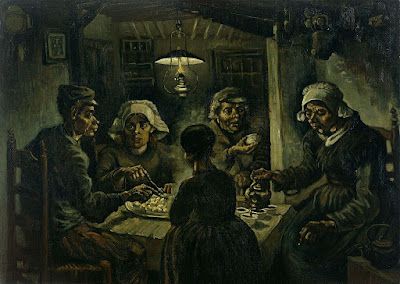The sun was shining this morning, so both Dan and I explored the picturesque village of Otterlo, each on our own schedule, before or after a hearty breakfast at the hotel restaurant.
Though the town is pretty, it's not really that old. Most of the buildings I saw were definitely 20th century.
I was even more surprised to run across a tableau of a painting by van Gogh called The Potato Eaters. It belongs to the Van Gogh Museum in Amsterdam, but the Kröller-Müller has an earlier, cruder version.
 |
| Tableau of The Potato Eaters |
 |
| Vincent van Gogh The Potato Eaters Internet grab from the van Gogh |
On the way out of town, we ran into a corn field with an appropriate display.
We drove about an hour east to the town of Apeldoorn to tour Paleis Het Loo.
Paleis Het Loo
The palace was built in the1680s (the late Golden Age) for King William III and Mary II of England. If these names sound familiar, it is because the pair were co-regents of England, as well as ruling in the Netherlands. They were cousins, and they were married very young (he was 14; she was 9) as a matter of Charles II's foreign policy. Here's a portrait made at the time of their betrothal; the artist, Anthony van Dyck, was a Flemish painter who often worked for Charles I of England.
 |
| Anthony van Dyck, 1599-1641 William II, Prince of Orange, and his Bride, Mary Stuart, 1641 I took this shot at the Rijksmuseum |
 |
| Captain Dan was impressed by the size of some of the trees around Paleis Het Loo. |
The symmetrical Dutch Baroque building is U-shaped and surrounds a plain paved courtyard, suitable for horse-drawn vehicles. For a palace, the structure is surprisingly austere and dignified.
 |
| Main structures of Paleis Het Loo |
The main attraction of the palace is the Great Garden out back, so we went through a basement passageway directly there. The garden is divided into several sections or parterres, each with its own layout and decorative features. Many of them have planting areas with graceful shapes.
One parterre had a classical pergola—that is, a colonnaded walkway. Nowadays you can have a light snack here while you enjoy the view.
 |
| The pergola has classical columns. |
The parterres are separated by walkways and water channels. This channel had koi swimming in it.
Statuary provided an important focal point in some parterres. The statues represent figures from Greek mythology.
Two of the parterres had unusual globe fountains in the center. One showed the astrological signs in the night sky, and the other showed the earth with its seas and continents.
One parterre had a raised embankment that enabled an excellent view of the pattern as a whole.
Flowering plants did not dominate the designs but they provided welcome color accents.
Our tour of the palace itself was brief and cursory. The decór has been restored to the way it was in the 1680s, more or less. Here are a few examples of the interior decoration.
We ended our tour by viewing a special exhibit about Sisi, an Austrian queen from the early 1800s. We had learned about her when we went to Vienna in 2005. No photos were allowed.
We couldn't have lunch in their attractive dining patio because we had to get the car back to the Hertz agency before the office closed at 6 p.m. Fortunately traffic was light and the trip took only a couple of hours, so we made it back in good time.
Since we had to skip lunch, we had a good appetite that evening. We ate down the street at the Fidelio Restaurant, which was named for Beethoven's only opera, Fidelio; the restaurant, like the Hotel Beethoven where we were staying, is located on Beethoven Street. I haven't mentioned this before, but Dan had dinner at Fidelio almost every night we were in Amsterdam, and I joined him if I had enough appetite. Besides being nearby, it had excellent food and service, and prices were reasonable. My favorite was a salad with goat cheese, walnuts, and raisins with a sweet vinaigrette dressing. Dan tried a variety of dishes.
We said goodnight to Amsterdam with regret. We could have hung out there a few more days.
























